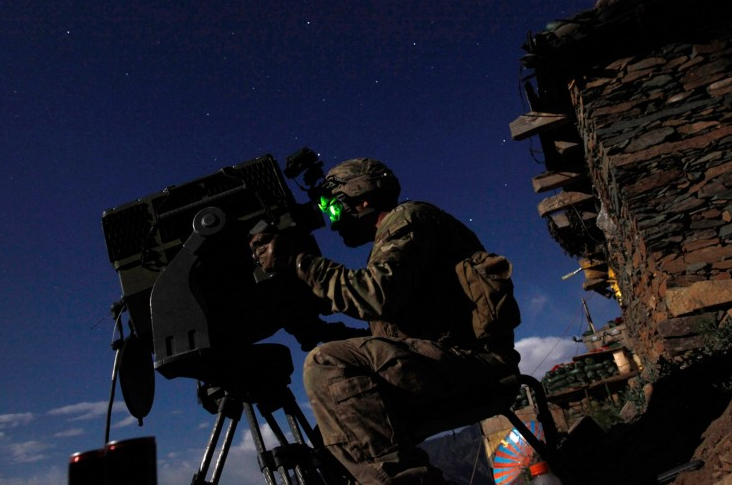There is something altogether haunting about this photograph. Shot in the evening, it is illuminated by the starlight (and perhaps a bright moon) but animated by the green glow of night vision. Rembrandt’s “The Night Watch” was famous for its use of light and dark to suggest movement where we might otherwise imagine a static frame, but here we get natural and artificial light as it combines to suggest a lone and anonymous presence stuck in an altogether static frame in a scene where we might otherwise anticipate agency and movement.
To get the point contrast the image with the photograph of the Raising of Old Glory on Mt. Suribachi during World War II. There too the soldiers are anonymous, but their anonymity is masked by their collectivity; we may not know who they are individually, but they are working as a team to a common and coordinated purpose. And, of course, it is a clearly national purpose, as symbolized by their connection to and effort on behalf of the flag. Here the soldier is an army of one and there are no markers of nationhood. Indeed, the only identifiable symbol in the photograph appears to be the top of a soda bottle (possibly a Coca Cola bottle, marked by the characteristic red cap, but there is no way of knowing for sure) which emerges from the bottom of the frame. But surely this soldier does not serve and sacrifice in the name of sugared water. Or at least one would hope that we are not fighting and dying in the name of commercial interests. The bigger point, however, is that there does not seem to be any movement at all as the soldier is hunched over, motionless, immobilized as he appears to be gazing trance-like into the past. Once again, contrast this with the photograph from Iwo Jima, where the image not only captures the raising of the flag at the height of its extension upwards, but also where the direction of such movement faces to the right of the frame, the more conventionally forward looking, future oriented direction.
According to the caption, this is a U.S. soldier sitting at an observation post in Afghanistan’s northeastern, Kunar Province. We are not told what he is looking at, but Kunar is a largely mountainous area besot with muddy rivers and rock filled, craggy pathways that combine to make passage treacherous if not impossible and so it is not hard to imagine the landscape he is observing. But what exactly he is looking for … that is hard to say. The war in Afghanistan is, of course, the longest war in America’s history, and Kunar has been the site of some of the fiercest battles between U.S. troops and Al Qaeda, the Taliban, and various mujahideen, but even for all that it is not clear what has been gained or lost (except for human lives, American and Afghani alike; the displacement of millions of individuals; and a price tag conservatively estimated at 600 Billion dollars) by such engagements. And yet, the photograph suggests, for all that we sit and watch. Static. Unmoving. Transfixed, it seems, by an advanced technology that allows us to see into the dark even if it is unclear what we are looking for—or what exactly we should do if we find “it.”
What makes the photograph haunting is perhaps how it functions as an eerie cipher for American involvement in Afghanistan writ large: individual, not collective; transfixed by a backward looking tunnel vision; and altogether immobile. In its own way, it perhaps encapsulates the current war in a manner similar to how Raising the Flag on Mt. Suribachi symbolized an earlier war–only in reverse.
Photo Credit: Tim Wimbome/Reuters

Discussion